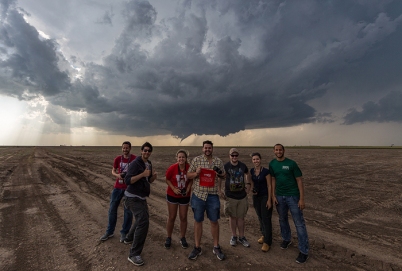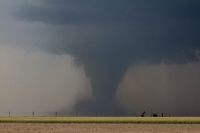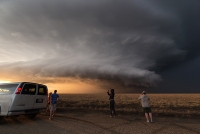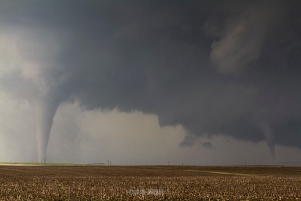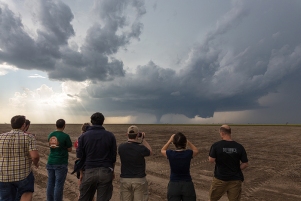Ogden News
Storm Chase class among ‘real world’ experiences offered by WKU Meteorology Program
- Thursday, August 25th, 2016
For students in WKU’s Meteorology Program, the forecast calls for a 100 percent chance of professional learning experiences through innovative student engagement activities.
“The common theme is thinking outside of the traditional classroom in ways that put the ‘real world’ in the hands of students prior to graduation,” said Dr. Josh Durkee, associate professor in the Department of Geography and Geology.
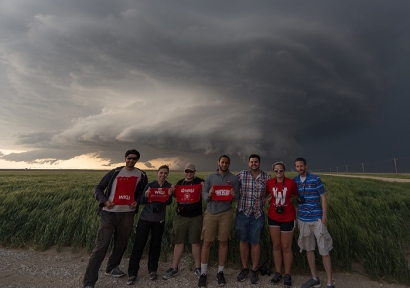
Participants in the 2016 WKU Storm Chase class traveled 7,002 miles across 12 states and documented at least 12 tornado touchdowns. (Photo courtesy of Josh Durkee)
Since his arrival in 2008, Dr. Durkee has created the WKU Storm Chase class, developed the College Heights Atmospheric Observatory for Students (CHAOS), a facility for students to practice forecasting and research outside of the classroom, and is preparing the launch of White Squirrel Weather, an exciting new WKU Meteorology operation.
“I truly enjoy student engagement on this level and post-graduate success, as well as student feedback, suggest it’s an educational experience of a lifetime. Everyone wins,” he said.
This year’s May term was the seventh offering of Dr. Durkee’s Field Methods in Weather Analysis and Forecasting class, which took students on a 7,002-mile journey across 12 states (Kentucky, Indiana, Illinois, Missouri, Tennessee, Arkansas, Kansas, Oklahoma, Texas, New Mexico, Colorado and Nebraska) during a two-week period. The purpose of the course is to provide students with a wildly unique and intensive capstone learning experience that enhances various meteorological skillsets.
“Students who experience the WKU Storm Chase gain practical forecasting experience, along with numerous opportunities to exercise written and oral communication, applications in geography and decision-making, storm-event documentation, photography and videography, and computer analytics,” Dr. Durkee said. “The landscape is also critical to understanding severe-storms forecasting, so even the fundamentals of geology and hydrology are discussed on a daily basis.”
Another unique twist to this year’s course was participation by two students from Brazil.
“We have been working with colleagues at the Federal University of Rio Grande do Sul in Brazil to document water vapor sources for large, severe thunderstorm complexes across Brazil,” Dr. Durkee said. “This year Flávia Moraes of Porte Alegre, Brazil, joined us as a Visiting Scholar to participate in the field course to gain a robust understanding of severe storms across the North American Plains. We also had the pleasure of having Lucas Cantos Almeida join us from the University of São Paulo Brazil as well.”
Upon returning to WKU, Dr. Durkee immediately set back out to the Plains to join Dr. Grady Dixon (Fort Hays State University, Kansas) and his storm chase group at Fort Hays State University for a seven-state (Kansas, Nebraska, South Dakota, North Dakota, Montana, Wyoming and Colorado), 6,081-mile adventure.
Dr. Durkee logged a total of 13,083 miles behind the steering wheel across 16 states this season, a path that stretched from the Rio Grande in southwest Texas to the Canadian border in north-central Montana.
“I effectively drove a distance similar to a constant-latitude trip around the entire world to and from WKU, and finished off with a drive to Chicago, Illinois,” he said. “It was incredibly challenging but among the most rewarding academic experiences I have accomplished.”
While the overall tornado frequency was below average this past season, the WKU storm chasers were able to document at least 12 tornado touchdowns, with some tornadoes that produced EF-3 rated damages (136-165 mph winds). Near Dodge City, Kansas, students documented up to three tornadoes on the ground simultaneously. The group also encountered numerous severe storms that produced large, damaging baseball-sized hail, flash floods and other destructive winds.
Students who participated in the 2016 WKU field course were: Isaac Bowers of Aurora, Indiana; Jonathan Calloway of Morgantown; Logan Mitchell of Hebron; Jessica Dobson of Louisville; Lucas Cantos Almeida of Recife, Brazil; Flávia Moraes of Porte Alegre, Brazil; and Jonathan Piercy of Pembroke.
Recaps of the 2016 storm chase are available on the WKU Meteorology Blog at http://meteorology.blog.wku.edu/. Follow the group on Twitter at https://twitter.com/wkustormchase.
Contact: Josh Durkee, (270) 745-8777
Some of the links on this page may require additional software to view.


